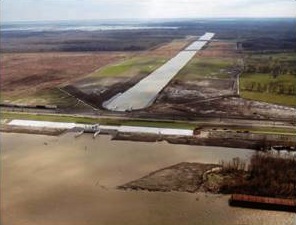A recently published study by a team of economists from Louisiana State University and Mississippi State University disputes the state’s claim that large sediment diversions are more cost-effective than slurry pipelines when building new land to replace Louisiana’s sinking wetlands.
The study concluded that some pipeline projects are more cost-effective because they build land quickly, while diversions take longer to construct and don’t create land for many years.
But the study also found there were limits to the advantages of pipelines. Pipes have a better cost-benefit ratio when the land-building takes place fewer than 20 miles from the sediment site; diversions perform better over longer distances and in time frames exceeding 50 years.
The study, “Trajectory economics: Assessing the flow of ecosystem services from coastal restoration,” looked at how much land could be built over a 50-year time frame by the two methods employed in the Coastal Protection and Restoration Authority’s Master Plan for the Coast 2012.

It was commissioned in 2008 by the research consortium Coastal Restoration and Enhancement through Science and Technology, based at LSU. The study was published this year in the peer-reviewed journal Ecological Economics.
Both dredging and diversions are integral parts of the 50-year, $50-billion Master Plan. Some fishing groups oppose diversions, fearing the change in water salinity will displace their target species.
Co-author Rex Caffey, director of the Center for Natural Resource Economics & Policy at LSU, stressed that the study does not endorse one type of land-building over another. He said the economists undertook the study because they believed the cost-benefit analysis used in the Master Plan didn’t include important factors.
The most obvious omission, they said, was that the Master Plan didn’t immediately count the benefits of land built by pipelines.
Co-author Daniel Petrolia, an agricultural economist at Mississippi State, said that by assigning equal value to acres built by diversions and pipeline projects, the state had ignored the value accrued by pipeline-created acres before diversions had created anything.
“It would be like saying if I put $20 in the bank, 10 years later it wouldn’t be worth any more than the $20 you just got,” he said. “That ignores the interest my $20 would have accrued while you were still waiting to get your $20.
“We’re saying you have to credit the services those acres are performing while you’re waiting for the diversion to build acres.”
A second factor the team said the state missed was the possible costs of what the economists call “socio-political” constraints. These include the influence of stakeholders such as fishers on diversion operations, who have prevented the freshwater diversions at Caernarvon and Davis Pond from flowing at peak efficiency, the economists said.
The state coastal authority “estimates the benefits of these projects as if they will be run at peak efficiency according to their designs, but that just ignores what has been the real-life experiences of these projects,” Caffey said.
The Coastal Protection and Restoration Authority did not respond to a request for comment.
The Lake Pontchartrain Basin Foundation supports the use of diversions. Executive Director John Lopez said the study showed some positive effects of diversions, but he questioned some of the metrics.
“I think it draws some important conclusions, the first being when diversions are operated at their full capacity, they can produce a great amount of land and do it at about a third the cost” of slurry pipelines, he said.
“And they show some very tangible results in marsh creation, whether it’s by the slurry pipelines or diversions. So, in a real way, they make the very strong case for funding the Master Plan, whichever method is used.”
But Lopez said he doesn’t believe the study gave enough weight to the effect of fuel prices in judging the cost-effectiveness of pipeline projects, especially when moving sediment great distances.
“If you’re going to include social constraints for diversions, then I thought to be balanced they should include those uncertainties as constraints for marsh creation,” he said.
Lopez said he believes the conclusions in the study support the Master Plan approach.
“It says we can’t get this done using only one method,” he said. “And each method works better under different conditions.”
